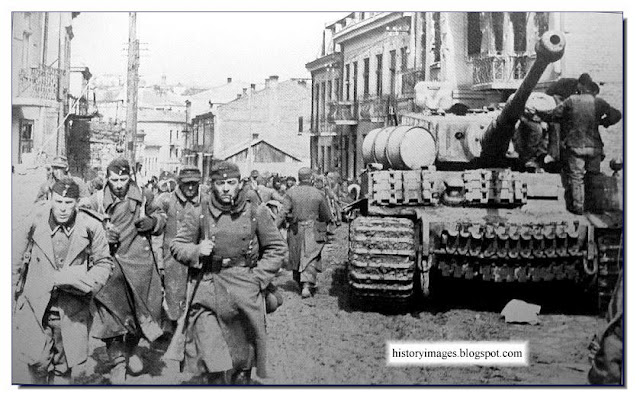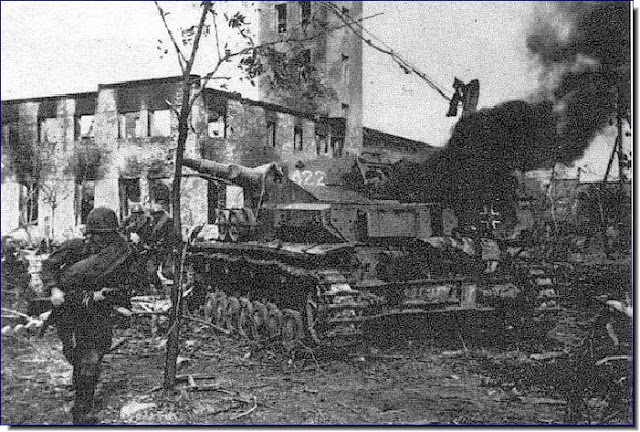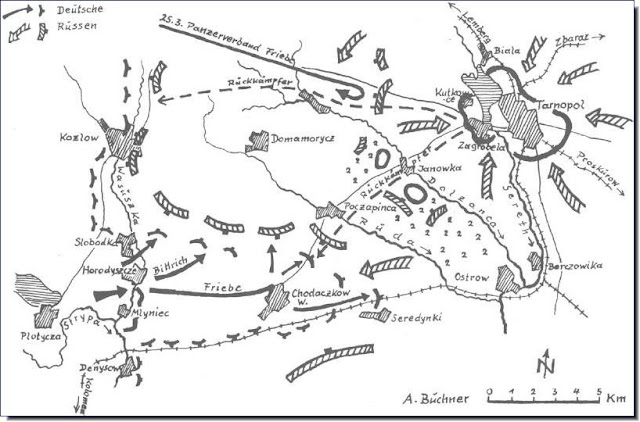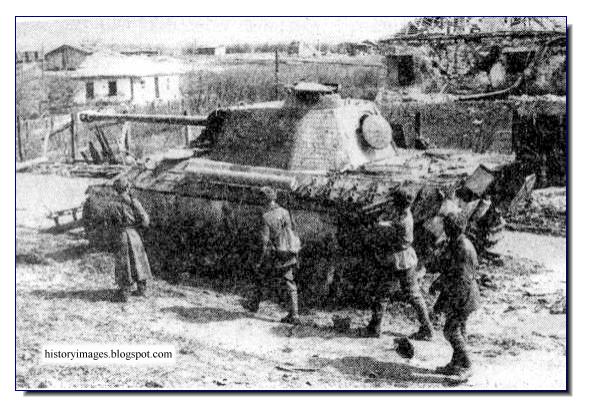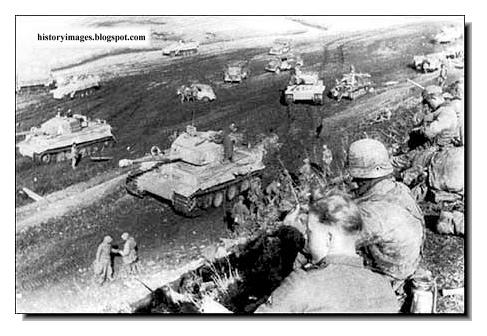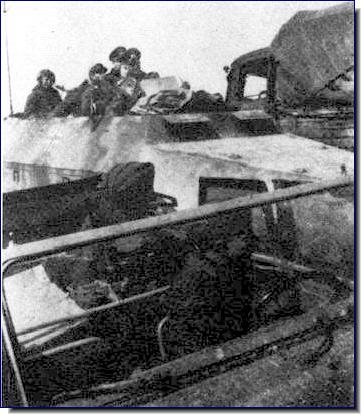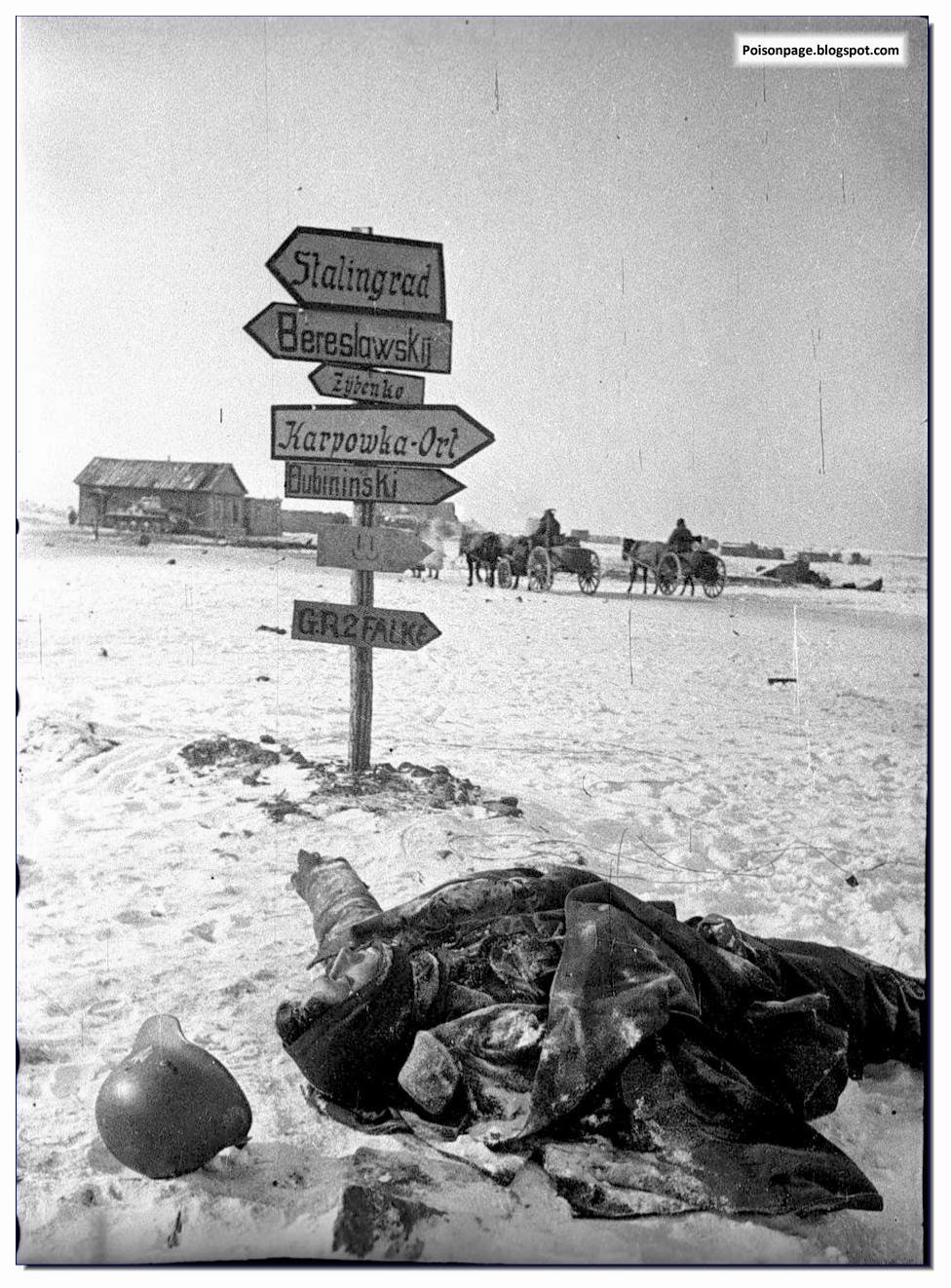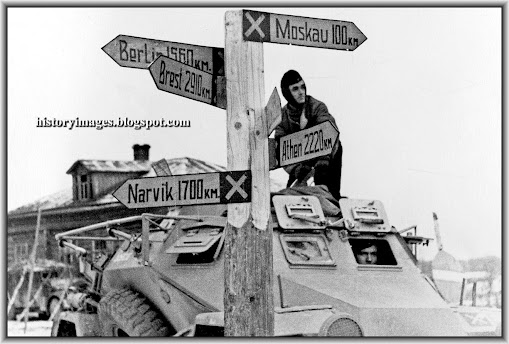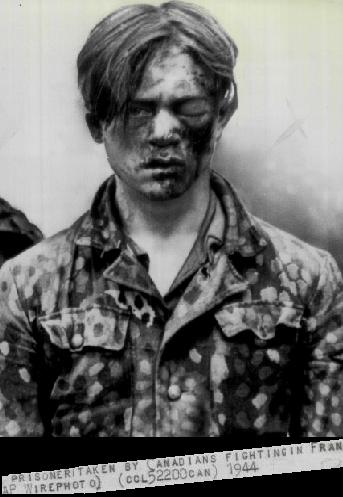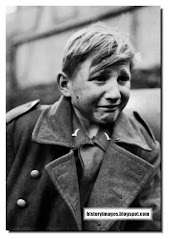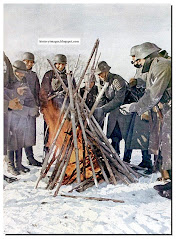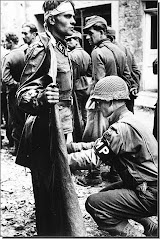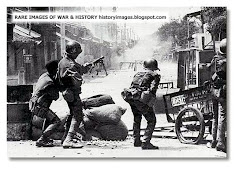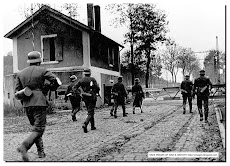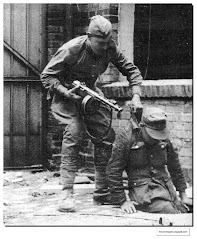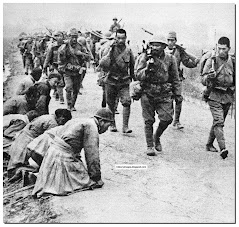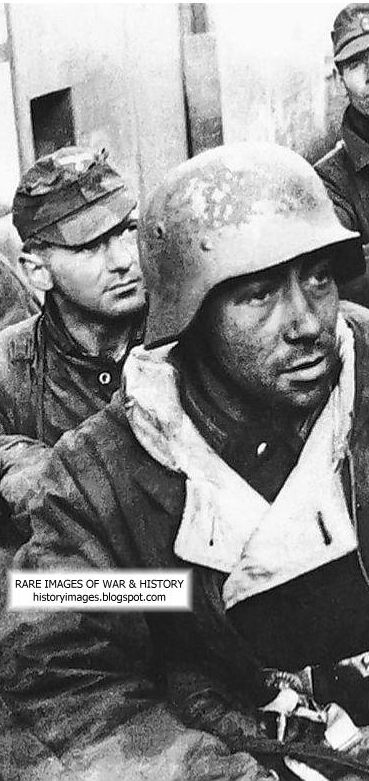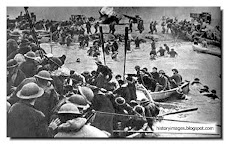Ternopil. In 1941 the city was occupied by the Germans who continued exterminating the population by murdering the Jews and sending others as forced labour to Germany. In April 1944 the city was retaken by the Red Army, the remaining Polish population having been previously expelled. During the Soviet reoccupation in March and April 1944, the city was encircled and completely destroyed. In March 1944 the city was declared a fortified place by Adolf Hitler, to be defended until the last round was shot. The stiff German resistance caused extensive use of heavy artillery by the Red Army, resulting in the complete destruction of the city and killing of nearly all German defenders. (55 survivors out of 4,500) Unlike many other occasions, where the Germans had practised a scorched earth policy during their withdrawal from territories of the Soviet Union, the devastation was caused directly by the hostilities.
In 1944 Tarnopol was a town of 35,000 people (Buchner, 1995). The city was about 40 km west of the old Soviet-Polish border on the east bank of the River Seret. It had been Polish from 1920, was annexed by the Soviets in 1939, and captured by the Germans in 1941 (Wikipedia: Tarnopol Voivodship). The town was a transport hub with several railway lines running through it, the most significant being the Lvov to Odessa line which was the last railway line east of the Carparthians linking these two cities. Cutting this railway line would force the Germans to supply their southern forces via the long route through Rumania. Tarnopol was in a largely flat area, although a sprinkling of low hills, small woods, and villages dotted the plain. The River Seret and a marsh bordered lake cut off the western section of the town, comprising the suburbs of Zagrobela and Kukowce, from the main part of town. The connection was via a bridge over a dam. Moniushko (2005) described the town as being of "well built brick" houses, although Buchner says "stone". Tarnopol was a German garrison town (4,600 men after reinforcements) and its only defences were field fortifications within a 2-3 km radius of the city centre. The town also lacked an airfield, and during the siege the garrison had to rely solely on unreliable air drops for supplies.
Note: Tarnopol (Polish) is also called Ternopol (Russian) and Ternopil (Ukrainian). Tarnopol was the name used in 1944.
The Russians pass an immobilised German tank in the town
The Russian "Mud Offensive" began on 4 Mar Zhukov (Erickson, 1996). Two Russian Fronts were operating in the vicinity of Tarnopol. Zhukov's 1st Ukrainian Front in front of Tarnopol and Koniev's 2nd Ukrainian Front to the south-east. As it only had indirect bearing on the events at Tarnopol I'll describe Koniev's activities first. The 2nd Ukrainian Front kicked off a day after Zhukov's men at dawn (0750 hours) on 5 Mar 1944. They smashed the German defences on the Gornyi Tikich and took the German depot at Uman on 10 Mar. On the evening of 11 Mar Russian units took the Dzhulinka and Gaivoron crossings on the Bug. Within 48 hours Russian units had crossed the river on a 80 km front. At 1300 hours on 17 Mar the lead units reached the Dniester and put bridgeheads on the western bank . On 19 Mar Moghilev-Podolskii was cleared allowing a full crossing of the Dniester - a entire Corps was across by noon on 21 Mar. This operation pushed the right flank of First Panzer Army back to the northwest away from the left flank of Eighth Army. Koniev's men reached the Soviet-Rumanian border on 25 Mar.
-----------------------
From Buchner, A. (1995). Ostfront 1944
From Buchner, A. (1995). Ostfront 1944
Other radio messages reached the commanding XXXXVIII Panzer Corps on April 1, including a report on equipment losses. For the three day period beginning March 30 these losses totalled thirty machine-guns, twelve heavy mortars, one light and one heavy infantry gun, one anti-tank gun and one anti-aircraft gun - a considerable loss of heavy weapons which could not be replaced.
The utter hopelessness of the situation became clear to Generalmajor von Neindorff, who had questioned the suitability of Ternopol as a "fortified place" from the beginning. He radioed: "Despite bitter resistance unable to hold on any longer. Request Führer's permission for a breakout attempt.
"Hitler's answer was not long in coming. That same day he decided that the"fortified place" was to continue to be held until it was possible to restore contact.But Ternopol had never been a "fortified place," and had now become a pocket
--------------------------
Zhukov's 1st Ukrainian Front attacked at 0800 hours on 4 Mar (Erickson, 1996). The rail line to Tarnopol was the central axis of advance, coinciding with the junction between Fourth and First Panzer Armies. Within 48 hours, and despite the clinging mud, the Russians had broken through on a 160 km front (Buchner, 1995, says 40), and Zhukov's tanks and motorised infantry had reached a depth of 40 km. The foot slogging infantry had to drag themselves and their equipment through the soaked earth, fighting isolated pockets of Germans as they advanced. By noon of 7 Mar the right wing of the Fourth Panzer Army had been pushed back to the Seret river, and some Russian troops had crossed. By the evening of the same day (7 Mar) three Soviet armies (60th, 3rd Guards Tank and 4th Tank) were closing on the line from Tarnopol to Chernyi-Ostrov. When tanks captured Volochisk, halfway between Tarnopol and Cheryni-Ostrov, they also cut the Lvov-Odessa railway line. German reinforcements stiffened resistance near the railway line in the Tarnopol-Proskurov sector, so Zhukov ordered Tarnopol bypassed to the south, thus cutting off the German garrison in the town.
First Encirclement (9-20 Mar 1944)
On 9 Mar Russian tanks and infantry broke into the Tarnopol (Buchner, 1995). German reinforcements, including anti-tank guns and assault guns, entered the town and rear echelon troops and civilians fled west. In heavy fighting the reinforced garrison had cleared the town of Russian troops by 11 Mar. Tarnopol, however, remained under continuous bombardment.
Meanwhile, and despite its weak garrison and poor defences, on 10 Mar 1944 Hitler declared Tarnopol the first "Fortified Place" (Buchner, 1995). As such it was to form a breakwater in the Soviet tide. The idea being that the garrison would remain in place while the Russians surrounded the town, thus tying up resources and hopefully delaying the Russian advance westward. With orders to hold on to the last man, the new commander, Generalmajor von Neindorff, organised the defence into four sectors: North, South, East and West (the Kutkowce and Zagrobela suburbs across the Seret). The troops dug in as best they could with the assault guns held in reserve for counter attacks.
Red Army soldiers examine a German Panther tank.Outskirts of Ternopil. April 1944
In the period 13-20 Mar, the reinforced XXXXVIII Panzer Corps attacked southeast of Tarnopol with some success (Buchner, 1995). They closed the gap with First Panzer Army and opened up the route to Tarnopol.
Kamenets-Podolskii Pocket (21 Mar - 7 Apr 1944)
On 21 Mar, with Koniev across the Dniester, Zhukov initiated the next step in his plan - a thrust toward Chernovitsy to encircle First Panzer Army (Buchner, 1995; Erickson, 1996). Zhukov's forces roared along the valley of Zbruch to the Dniester crossing at Zaleshchiki. German resistance was flattened and by 27 Mar Zhukov's advance elements were close to Chernovitsy. Vinnitsa was also taken. By 28 Mar Koniev's and Zhukov's forces met up and some 200,000 men of First Panzer Army were encircled in the Kamenets-Podolskii sector south-west of Vinnitsa. The cordon was only loosely held and First Panzer began fighting its way westward. On 4 Apr two SS Panzer divisions tried to break the circle from the outside, at Podgaitsy. Their opponents fell back to Buchach, where on 7 Apr the SS relief force met the badly mauled First Panzer coming westward. Fighting continued north of Buchach to mid-April but First Panzer Army was saved.
Second Encirclement (23 - 24 Mar 1944)
The Russians advance towards Tarnapol
During 21-24 Mar the Soviet 60th Army (11 rifle divisions, 1 artillery division and IV Guards Tank Corps) drove XXXXVIII Panzer Corps back to the Wosuzka River (Buchner, 1995). By 23 Mar Tarnopol was surrounded for the second and final time. Tarnopol was now 20 km behind Russian lines.
Russian attacks on Tarnopol also resumed on 23 Mar (Buchner, 1995). Tanks and infantry attacked from the north, south and east, but the defenders managed to fend the Russians off. The attacks continued the next day (24 Mar) but now included assaults on the western sector across the Seret as well. Both western suburbs were lost, Kutkowce permanently, but Zagrobela changed hands several times during the day and ended up in German control. Despite the relative lack of success of their attacks, by the evening of 24 Mar the Russians had four Rifle Divisions plus tanks, artillery and rocket launchers in place around the town.
Panzerverband Friebe to the rescue (25 Mar 1944)
At 0430 hours on 25 Mar Oberst Friebe set out with an armoured battle group from 8th Panzer Division to break through to Tarnopol (Buchner, 1995). Friebe had the 2nd and 10th Panzer Regiments (including a Panther Battalion which led the way), and two half track mounted battalions of Panzer Grenadiers (1st Battalion from 8th Panzergrenadier Regiment and 1st Battalion from 74th Panzergrenadier Regiment). The battle group had to advance through mud, under artillery fire, across the Dolzanca River and then over three rows of hills, each with entrenched Russians. When the tanks stalled in front of defensive positions the Panzergrenadiers dismounted to clear them. By late afternoon the battle group managed to push through three Russians positions before reaching a fourth in woods 4 km west of Zagrobela. Under pressure from concealed anti-tank guns and anti-tank rifles, artillery, mortars, and ground support aircraft, Friebe decided his men could go no further and withdrew to regroup for an advance to the southeast. This second advance never happened as further casualties and the resulting confusion forced the battle group back to the German lines.
Red Army soldiers rest during a lull in the fighting
Withdrawal to edge of city (25 - 30 Mar 1944)
This relief attempt in fact brought no relief as the Russians continued to press Tarnopol on 25 Mar even as Friebe approached (Buchner, 1995). A Russian regiment deeply penetrated the eastern sector and was only evicted after much heavy fighting. During the evening the Germans in the northern sector saw off an attack by 17 tanks and escorting infantry. Simultaneously the defenders of Zagrobela in the west were mauled by a ferocious attack.
In the period 25-27 Mar the defenders could also see a steady flow of Russian reinforcements arriving, particularly in the west where the relief effort was foreseen (Buchner, 1995). The garrison experienced continuous artillery and mortar bombardment. Russian reconnaissance missions were frequent and increasing in number.
The next Russian attack began on 28 Mar with a 2 hour bombardment (Buchner, 1995). A Russian Rifle Division, supported by tanks, artillery and close support aircraft soon followed, attacking the young soldiers of 949th Grenadier Regiment in the south-eastern sector. The 2nd Battalion broke and was heavily mauled. Counter-attacks could not evict the Russians.
On 29 Mar another German counter-attack failed to pinch off the Russian penetration in the southeast and the defenders were forced to withdraw to the edge of the city (Buchner, 1995). The same day the Russians penetrated positions of the 949th Grenadier Regiment along Access Road IV.
Russian soldiers pose against the destroyed Ternopil Fort
Shortening the perimeter (31 Mar - 9 Apr 1944)
Fighting continued but the next major Russian effort was on 31 Mar (Buchner, 1995). After several hours of bombardment strong Russian forces attacked between the two Railway lines in the east. They broke through the defensive positions and pushed as far as the Rail Station. In the absence of reserves the defenders in the north and south were withdrawn to the town edge. By now the garrison was squeezed into a pocked 1 x 1.5 km, and was entirely within the confines of the town. Continuous heavy shelling resulted in the destruction of most of the town. The fighting had devolved into typical urban combat with small groups fighting for every street and house. Moniushko (2005), who passed through a couple of months later, said the Germans had converted the well built brick houses into pill-boxes.
BRUTAL WAR...
On April 5 the Soviets blanketed the city with fire from heavy batteries and aircraft showered the defenders with bombs. Nevertheless, the infantry assault which followed the bombardment was stopped. Afterward the Soviet infantry pulled back again, allowing their artillery to resume its bombardment of the city. The tightly-stretched German defensive ring held out against several subsequent attacks. This day was the most difficult so far in the fourteen-day siege, and German casualties were very high. Probably as a result of the astonishing German resistance, the next day did not see a resumption by the Soviets of their concentric attacks
In the first two days of April fighting was particularly heavy in the west and east-southeast (Buchner, 1995). On 1 Apr the Russians penetrated the positions of the veteran Demba Fusilier Battalion in the western suburb of Zagrobela. On 2 Apr the Demba Fusilier Battalion cleared the penetration and drove off two subsequent Russians attacks (infantry supported by tanks). The defenders were less successful elsewhere, being driven back in the east and southeast. The last German reserves were use to blunt a Russian push towards the centre of the town. 10 Russian tanks were destroyed in the process. On 3 Apr the Russians tried and failed again. By this stage Stuka dive bombers were acting as flying artillery, hitting Russian troop concentrations around the town. On 4 Apr the Russians attacked again, forcing the defenders to shorten their perimeter again. On 5 Apr several more Russian assaults was repulsed. On 6-8 Apr there was some respite with the Russians contenting themselves to small raids.
A murderous struggle had begun, in which every officer and man was in the front lines. Soldiers young and old fought with the courage of desperation. Elements of the 949th Grenadier Regiment, which had failed several days earlier, were now fighting well, and received the full recognition of the commandant.
German prepare to attack and relieve those trapped at Tarnapol. April 1944
BRUTAL WAR....
Over the city itself hung a black, brown and gray cloud deck. Fiery flashes shot from the fountains of smoke and dust which marked the points of impact of incoming artillery rounds. The air was filled with thundering, crashing and roaring sounds.Flames leapt high into the air, houses collapsed and walls crashed to the ground.Projectiles howled and whistled in from all sides from Soviet heavy mortars, from 76.2mm "Ratschbum" all-purpose guns, 122mm and 172mm heavy guns and from"Stalin Organ" rocket launchers. Street and house fighting raged in every corner and end of the city. Troops of the Red Army, clad in their earth-brown uniforms,charged with shouts of "Urray!", firing their sub machine-guns, rapid-firing rifles,anti-tank rifles and light machine-guns and throwing hand grenades. They worked their way forward over piles of rubble and through tangled beams, many of them falling under the hammering defensive fire. Ever-smaller groups of German defenders held on bitterly, fighting for every street, every block of houses and every shattered building. The infantry barricaded themselves in the stout stone buildings, firing from windows, cellars and holes in the roofs. German anti-tank guns dug into the rubble fired until they had no more ammunition. The few assault guns and self-propelled guns still left rumbled through the rubble-filled, deserted streets, responding to enemy breakthroughs with immediate counterattacks.Groups of Russians which succeeded in infiltrating the German lines were flushed out and driven back with hand grenades and small arms. Some barricaded themselves inside houses, which were blown up. But the Russians kept coming,smoking out the German nests of resistance with incendiary shells and flamethrowers.
On 9 Apr the four surrounding Russians divisions attacked in unison after a bombardment lasting several hours (Buchner, 1995). The defenders succeeded in seeing off the attacks in the north and west, but had to shorten their lines to cope with Russian penetrations in the east and south. The Russians used direct fire from anti-tank guns, light artillery and the massive SU-152 assault guns ( Moniushko, 2005) to destroy the German strong points.
The Germans tried to relieve Tarnopol but in vain
On 11 Apr the second relief attempt set out (Buchner, 1995). Once again Oberst Friebe set out with his armoured battle group (Panzerverband), but this time the 9th SS-Panzer Division Hohenstaufen was in support. Panzerverband Friebe stalled in the face of strong defensive fire and Hohenstaufen was delayed at at the Wosuszka river. It took until the morning of 14 Apr for pioneers of the division to put a bridge across the river. Friebe led 71 tanks and 27 assault guns toward Tarnopol but the going was still slow. They took Chodaczow Wielki on the evening on 15 Apr, only 9 km from their starting point. There they had to wait for air dropped supplies before continuing on the 16th. By then it was too late.
Last stand (11 - 16 Apr 1944)
As with the earlier relief attempt, the Germans efforts did not stop the Russians from exerting pressure on Tarnopol itself (Buchner, 1995; note, Buchner seems to get confused about dates from this point in the narrative and consistently says March when April is intended). The Russians achieved several penetrations on 11 Apr, which the defenders managed to seal off. The Germans could not, however, deal with the major attack launched on the night of 11-12 Apr. On 13 Apr a Russian attack from the south split Zagrobela in the west from the main position in the centre of the town. On the night of 13-14 Apr most of the garrison moved across to Zagrobela as a prelude to a breakout. They had 1,300 men, one tank, two assault guns, two self-propelled guns, one anti-tank gun and two light infantry guns. Another 200 men, divided into small groups, remained in the east to delay the enemy, but were pushed out on the night of 14-15 Apr.
Generalmajor von Neindorff still firmly believed that the relief attack was well under way, but his radio messages requesting help and information as to the progress of the attack were becoming ever more desperate.These messages are typical:
April 12, 2125: Situation extremely desperate, penetrations can no longer be cleared up, contact lost between units. Serious consequences be expected from further enemy pressure. Relief imperative before it is too late.
April 13, 0650: All sectors under heavy pressure through the entire night. New penetration northern wing. Hemmed in further in west,pressure from north toward the bridge.
At 0905: Garrison under pounding in ruins since
At 0700. Enemy tanks and anti-tank guns in the streets, as well preparatory artillery and mortar fire.
At 1255: Heavy barrages on entire defensive perimeter since 1000.Infantry attacks in the south. Critical situation urgently requires relief.
At 1520: House-to-house fighting in the south and east. Ammunition running low. Where is relief?
The Russians continued to shell, bomb, and strafe the remaining Germans clustered into a 1 km square centred on semi rural Zagrobela (Buchner, 1995). Ground attacks were also launched and at noon on 15 Apr the pocket radioed to say their commander had died in close quarter fighting.
At noon on March 15 came the last radio message from the Zagrobela pocket. It reported the death of the commandant. Generalmajor von Neindorff had fallen in close-quarters fighting.
Another relief attack — the Commander-in-Chief of Army Group North Ukraine, Feldmarschall Model (in background, left) accompanied the attack in the leading half-track.
Following the death of Generalmajor von Neindorff, Oberst von Schönfeld assumed command of the remains of the garrison now squeezed into Zagrobela.There were about 1,500 men, but the situation in Zagrobela was hopeless from the beginning. It was a pocket about 1,000 meters in diameter in an area surrounding the open, village-like residential area. There was next to no cover available, and the area was under constant bombardment from Soviet heavy weapons and was subjected to waves of bombing and strafing attacks from the air. Since most of the houses there were made of clay or wood with no cellars, losses mounted extremely quickly. The wounded were placed in the few available cellars. For the worn-out,exhausted, battered German soldiers, with their bearded, smoke-blackened, emaciated faces, and their sad eyes, the situation in the cover less terrain was catastrophic. Rations, which had been relatively plentiful in Ternopol, now began to run short, as only the most vital things had been brought over from the city. Worst of all, there was scarcely any water. The single well was under enemy fire day and night until it was completely destroyed. The troops suffered from the shortage of drinking water, the wounded worst of all. All that could be done was to wet their lips with vodka; there was no way to get water for the new wounded. Moreover,ammunition was running out and the last radio had been put out of action.
Breakout (16 - 18 Apr 1944)
At 0200 hours on 16 Mar the survivors that were still mobile attempted to break out (Buchner, 1995). Taking the Russians by surprise they managed to break through the inner ring relatively easily. At this point they divided into two groups of about 700 men. One group headed west and the other southwest. The latter group crossed the hills southwest of Zagrobela, into a wood south of the village of Janovka. There they eliminated some Russian anti-tank gun and artillery emplacements, however, under being attacked from flanks and rear they were pushed out of the forest toward the west. By this stage all the officers had been killed. The survivors formed small groups and tried to break through, but only 43 reached the German armour at Chodaczow on 17 Apr. Little is known of the fate of the other group, however, on the morning of 16 Apr five men managed to reach the positions of the 357th Infantry Division north of Kozlov. Two more men appeared north of Kozlov on 18 Apr. Finally five prisoners were returned to Germans lines for propaganda purposes. That made a total of 55 who reach safety out of the original 4,600 men.
The attempt to save Tarnopol
At its peak the garrison had 4,600 men (Buchner, 1995). This included quite a range of types including under trained youths, older militiamen, volunteers, Waffen-SS troops, and regular soldiers. They were short of ammunition, in particular for artillery and heavy weapons. After reinforcements the garrison comprised:
The Germans At Tarnapol
Fortress Commandant with Staff (Generalmajor von Neindorff)
Two battalions of the 949th Grenadier Regiment (from 359th Infantry Division) - young soldiers with cursory training.
Demba Fusilier Battalion (a veteran unit)
543rd Regional Defence Battalion
500th Proving Battalion
Mitscherling Battalion (3rd Battalion, 4th SS-Volunteer Regiment, from Galizien Division)
The remnants of 3rd Battalion, 4th SS-Volunteer Regiment (from Galizien Division) in company strength
Kampfgruppe Grundmann (company strength)
Alert Company (from elements of the 8th Panzer Division)
Alert Company Vogel
4th Battalion, 359th Artillery Regiment with 3 Batteries
3 x 10.5 cm guns
8 x 15.0 cm guns
1 x battery of assault guns with 9 assault guns
1 x anti-tank company with 6 guns *
1 x Self-propelled artillery battery of the "LAH" with 6 guns
Remnants of 4th Battery, 384th Flak Battalion
3 x 2.0 cm anti-aircraft guns
4 x 8.8 cm anti-aircraft guns
Other small units
* The total complement of anti-tank guns for the entire garrison was 15, including some outdated 3.7 cm Pak 35/36. It is probable that the nine unaccounted for anti-tank guns were part of infantry battalions.
It is possible it was the Soviet 13th Army around Tarnopol as this unit was assigned the task to push westward whilst the rest of the Front moved south ( Moniushko, 2005)
Only a few surviving German soldiers appeared in the morning mist East of Chodaczow-Wielki
References
Buchner, A. (1995). Ostfront 1944: The German Defensive Battles on the Russian Front 1944 [D. Johnston Trans.]. PA: Schiffer.
Erickson, J. (1996). The Road to Berlin: Stalin's war with Germany: Volume Two. Phoenix Giants.
Moniushko, E. D. (2005). From Leningrad to Hungary: Notes of a Red Army soldier, 1941-1946 (O. Sheremaet, Trans; D. M. Glantz, Ed.). Frank Cass.
